Crisis Management and Reflection Report - Module Name and Details
VerifiedAdded on 2022/09/25
|22
|4907
|42
Report
AI Summary
This report comprehensively examines crisis management, focusing on its four key phases: prevention, preparation, response, and recovery. It discusses how organizations can mitigate risks associated with unexpected events, including natural disasters and other disruptive incidents. The report explores various strategies, such as collaborative emergency management, pre-season planning, and the importance of communication and technology in effective crisis response. It emphasizes the significance of employee involvement in crisis planning and the need for restorative practices during the recovery phase. Furthermore, the report incorporates a reflection on the group and individual activities undertaken during the completion of the assignment, analyzing the learning experiences and challenges encountered. The assignment draws on various academic sources and real-world examples to provide a comprehensive understanding of crisis management and its practical implications.
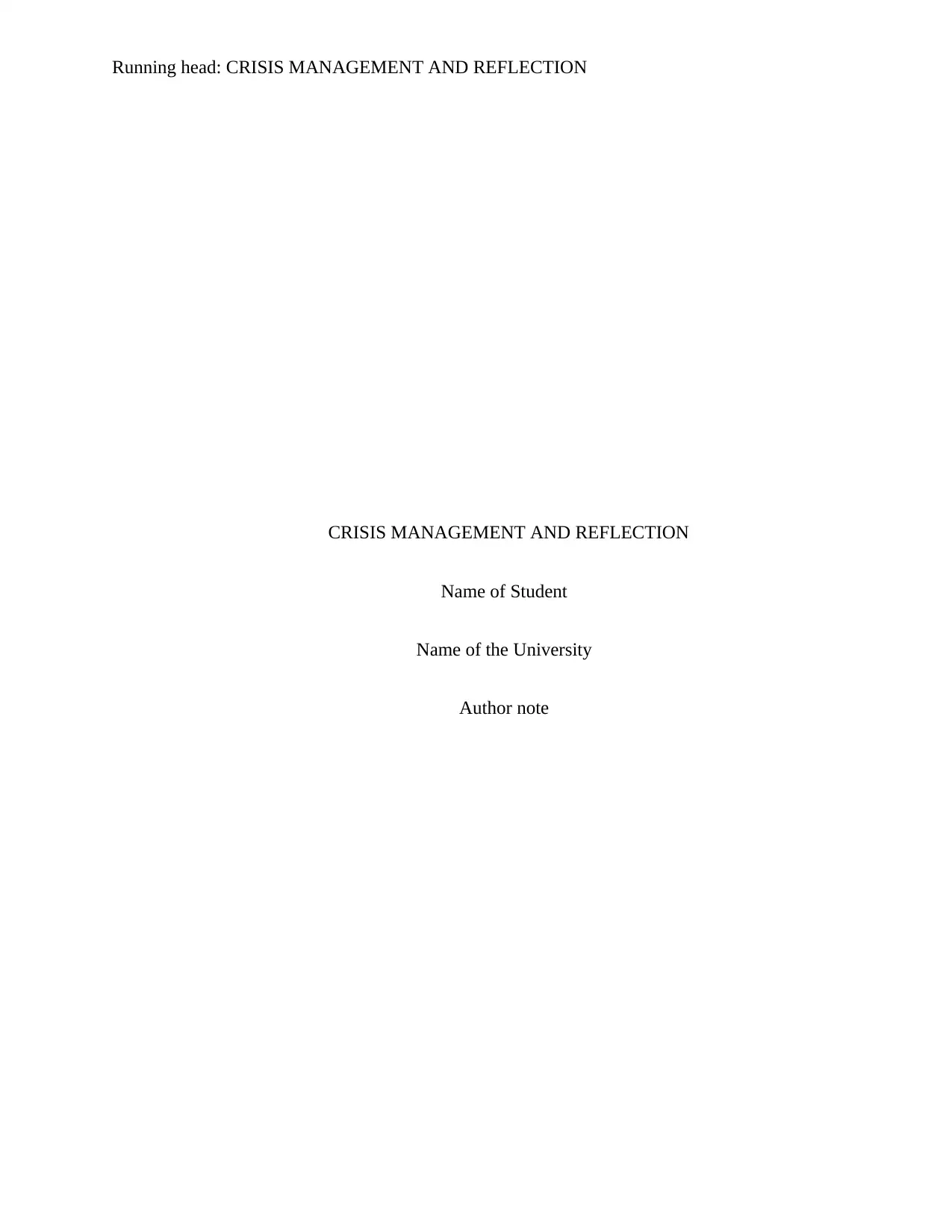
Running head: CRISIS MANAGEMENT AND REFLECTION
CRISIS MANAGEMENT AND REFLECTION
Name of Student
Name of the University
Author note
CRISIS MANAGEMENT AND REFLECTION
Name of Student
Name of the University
Author note
Paraphrase This Document
Need a fresh take? Get an instant paraphrase of this document with our AI Paraphraser

1CRISIS MANAGEMENT AND REFLECTION
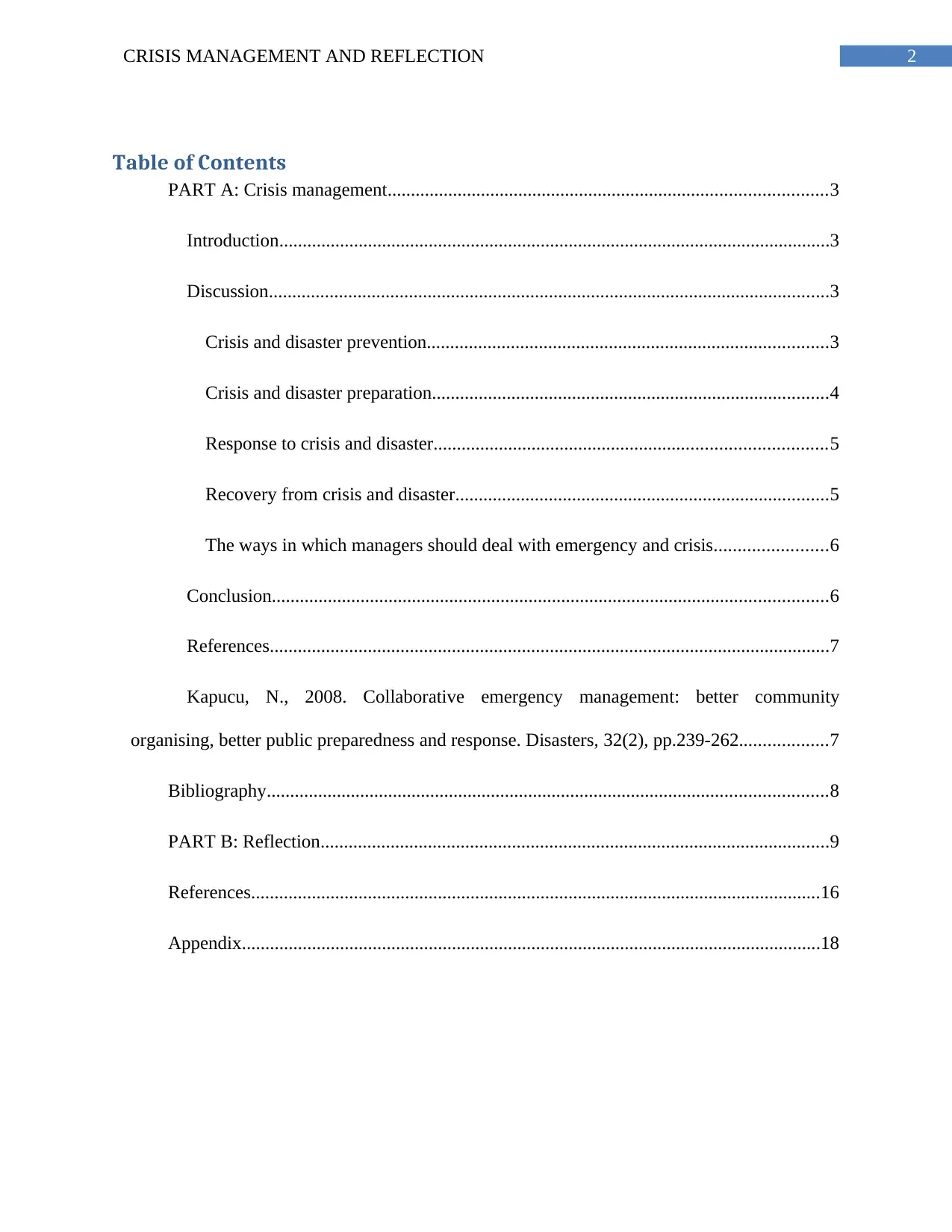
2CRISIS MANAGEMENT AND REFLECTION
Table of Contents
PART A: Crisis management..............................................................................................3
Introduction......................................................................................................................3
Discussion........................................................................................................................3
Crisis and disaster prevention......................................................................................3
Crisis and disaster preparation.....................................................................................4
Response to crisis and disaster....................................................................................5
Recovery from crisis and disaster................................................................................5
The ways in which managers should deal with emergency and crisis........................6
Conclusion.......................................................................................................................6
References........................................................................................................................7
Kapucu, N., 2008. Collaborative emergency management: better community
organising, better public preparedness and response. Disasters, 32(2), pp.239-262...................7
Bibliography........................................................................................................................8
PART B: Reflection.............................................................................................................9
References..........................................................................................................................16
Appendix............................................................................................................................18
Table of Contents
PART A: Crisis management..............................................................................................3
Introduction......................................................................................................................3
Discussion........................................................................................................................3
Crisis and disaster prevention......................................................................................3
Crisis and disaster preparation.....................................................................................4
Response to crisis and disaster....................................................................................5
Recovery from crisis and disaster................................................................................5
The ways in which managers should deal with emergency and crisis........................6
Conclusion.......................................................................................................................6
References........................................................................................................................7
Kapucu, N., 2008. Collaborative emergency management: better community
organising, better public preparedness and response. Disasters, 32(2), pp.239-262...................7
Bibliography........................................................................................................................8
PART B: Reflection.............................................................................................................9
References..........................................................................................................................16
Appendix............................................................................................................................18
⊘ This is a preview!⊘
Do you want full access?
Subscribe today to unlock all pages.

Trusted by 1+ million students worldwide

3CRISIS MANAGEMENT AND REFLECTION
Paraphrase This Document
Need a fresh take? Get an instant paraphrase of this document with our AI Paraphraser
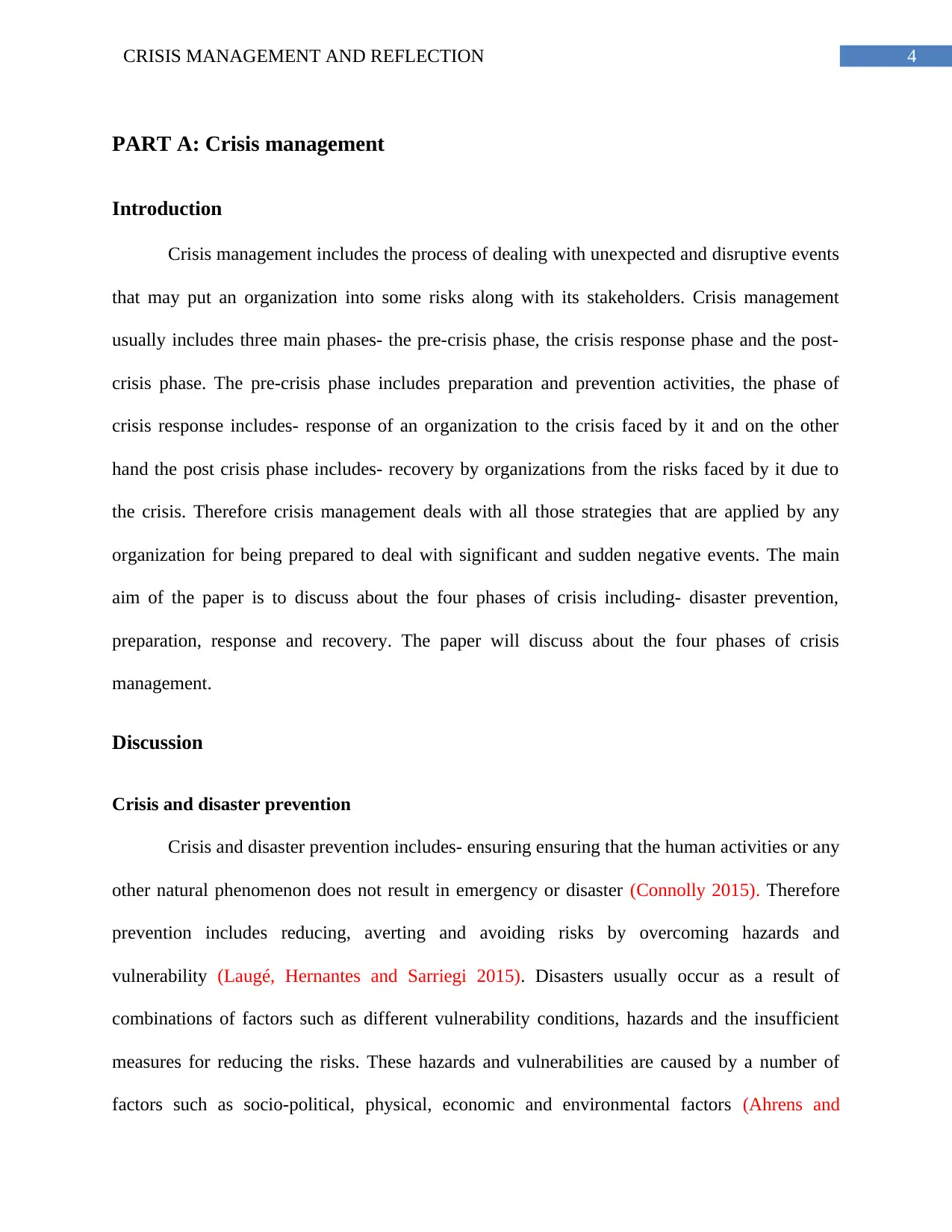
4CRISIS MANAGEMENT AND REFLECTION
PART A: Crisis management
Introduction
Crisis management includes the process of dealing with unexpected and disruptive events
that may put an organization into some risks along with its stakeholders. Crisis management
usually includes three main phases- the pre-crisis phase, the crisis response phase and the post-
crisis phase. The pre-crisis phase includes preparation and prevention activities, the phase of
crisis response includes- response of an organization to the crisis faced by it and on the other
hand the post crisis phase includes- recovery by organizations from the risks faced by it due to
the crisis. Therefore crisis management deals with all those strategies that are applied by any
organization for being prepared to deal with significant and sudden negative events. The main
aim of the paper is to discuss about the four phases of crisis including- disaster prevention,
preparation, response and recovery. The paper will discuss about the four phases of crisis
management.
Discussion
Crisis and disaster prevention
Crisis and disaster prevention includes- ensuring ensuring that the human activities or any
other natural phenomenon does not result in emergency or disaster (Connolly 2015). Therefore
prevention includes reducing, averting and avoiding risks by overcoming hazards and
vulnerability (Laugé, Hernantes and Sarriegi 2015). Disasters usually occur as a result of
combinations of factors such as different vulnerability conditions, hazards and the insufficient
measures for reducing the risks. These hazards and vulnerabilities are caused by a number of
factors such as socio-political, physical, economic and environmental factors (Ahrens and
PART A: Crisis management
Introduction
Crisis management includes the process of dealing with unexpected and disruptive events
that may put an organization into some risks along with its stakeholders. Crisis management
usually includes three main phases- the pre-crisis phase, the crisis response phase and the post-
crisis phase. The pre-crisis phase includes preparation and prevention activities, the phase of
crisis response includes- response of an organization to the crisis faced by it and on the other
hand the post crisis phase includes- recovery by organizations from the risks faced by it due to
the crisis. Therefore crisis management deals with all those strategies that are applied by any
organization for being prepared to deal with significant and sudden negative events. The main
aim of the paper is to discuss about the four phases of crisis including- disaster prevention,
preparation, response and recovery. The paper will discuss about the four phases of crisis
management.
Discussion
Crisis and disaster prevention
Crisis and disaster prevention includes- ensuring ensuring that the human activities or any
other natural phenomenon does not result in emergency or disaster (Connolly 2015). Therefore
prevention includes reducing, averting and avoiding risks by overcoming hazards and
vulnerability (Laugé, Hernantes and Sarriegi 2015). Disasters usually occur as a result of
combinations of factors such as different vulnerability conditions, hazards and the insufficient
measures for reducing the risks. These hazards and vulnerabilities are caused by a number of
factors such as socio-political, physical, economic and environmental factors (Ahrens and
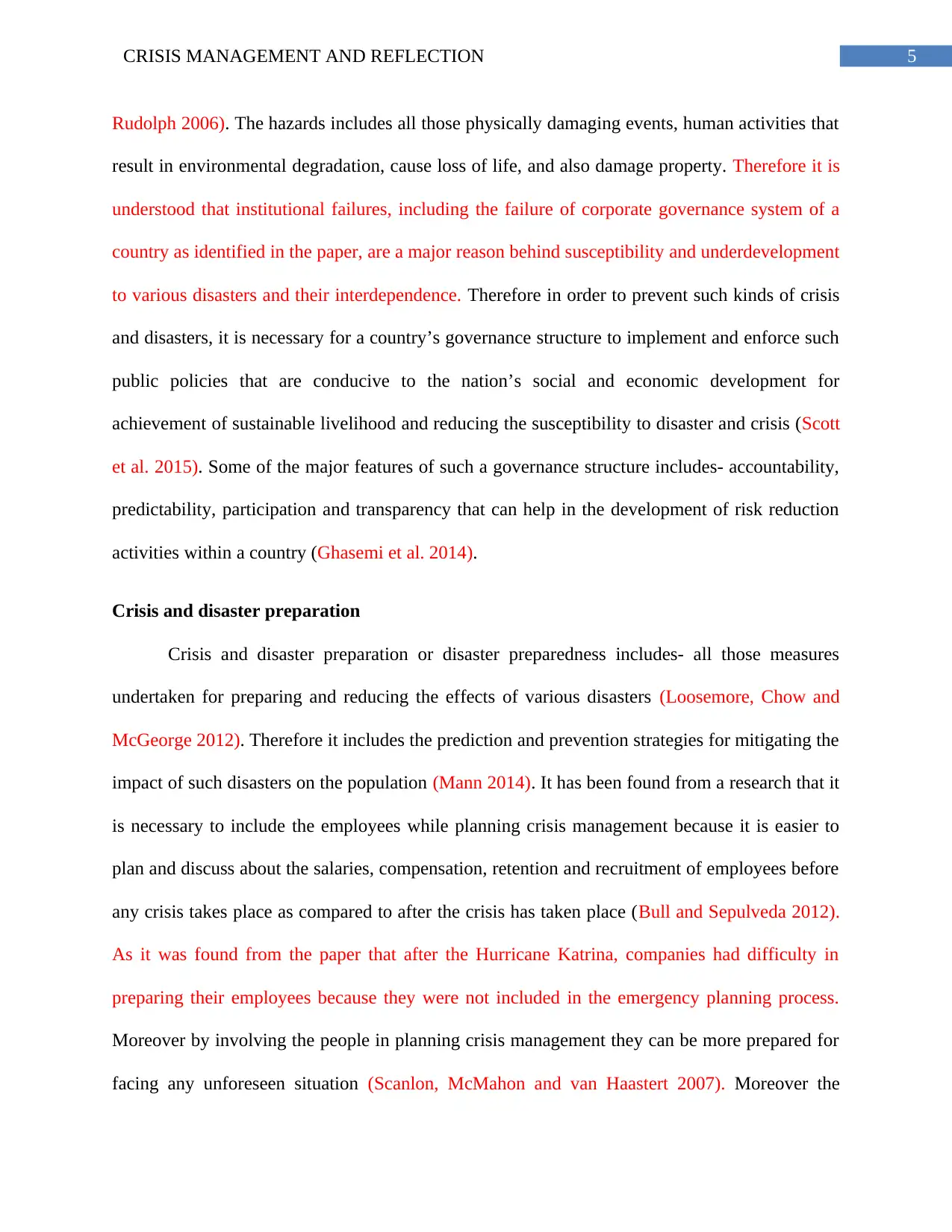
5CRISIS MANAGEMENT AND REFLECTION
Rudolph 2006). The hazards includes all those physically damaging events, human activities that
result in environmental degradation, cause loss of life, and also damage property. Therefore it is
understood that institutional failures, including the failure of corporate governance system of a
country as identified in the paper, are a major reason behind susceptibility and underdevelopment
to various disasters and their interdependence. Therefore in order to prevent such kinds of crisis
and disasters, it is necessary for a country’s governance structure to implement and enforce such
public policies that are conducive to the nation’s social and economic development for
achievement of sustainable livelihood and reducing the susceptibility to disaster and crisis (Scott
et al. 2015). Some of the major features of such a governance structure includes- accountability,
predictability, participation and transparency that can help in the development of risk reduction
activities within a country (Ghasemi et al. 2014).
Crisis and disaster preparation
Crisis and disaster preparation or disaster preparedness includes- all those measures
undertaken for preparing and reducing the effects of various disasters (Loosemore, Chow and
McGeorge 2012). Therefore it includes the prediction and prevention strategies for mitigating the
impact of such disasters on the population (Mann 2014). It has been found from a research that it
is necessary to include the employees while planning crisis management because it is easier to
plan and discuss about the salaries, compensation, retention and recruitment of employees before
any crisis takes place as compared to after the crisis has taken place (Bull and Sepulveda 2012).
As it was found from the paper that after the Hurricane Katrina, companies had difficulty in
preparing their employees because they were not included in the emergency planning process.
Moreover by involving the people in planning crisis management they can be more prepared for
facing any unforeseen situation (Scanlon, McMahon and van Haastert 2007). Moreover the
Rudolph 2006). The hazards includes all those physically damaging events, human activities that
result in environmental degradation, cause loss of life, and also damage property. Therefore it is
understood that institutional failures, including the failure of corporate governance system of a
country as identified in the paper, are a major reason behind susceptibility and underdevelopment
to various disasters and their interdependence. Therefore in order to prevent such kinds of crisis
and disasters, it is necessary for a country’s governance structure to implement and enforce such
public policies that are conducive to the nation’s social and economic development for
achievement of sustainable livelihood and reducing the susceptibility to disaster and crisis (Scott
et al. 2015). Some of the major features of such a governance structure includes- accountability,
predictability, participation and transparency that can help in the development of risk reduction
activities within a country (Ghasemi et al. 2014).
Crisis and disaster preparation
Crisis and disaster preparation or disaster preparedness includes- all those measures
undertaken for preparing and reducing the effects of various disasters (Loosemore, Chow and
McGeorge 2012). Therefore it includes the prediction and prevention strategies for mitigating the
impact of such disasters on the population (Mann 2014). It has been found from a research that it
is necessary to include the employees while planning crisis management because it is easier to
plan and discuss about the salaries, compensation, retention and recruitment of employees before
any crisis takes place as compared to after the crisis has taken place (Bull and Sepulveda 2012).
As it was found from the paper that after the Hurricane Katrina, companies had difficulty in
preparing their employees because they were not included in the emergency planning process.
Moreover by involving the people in planning crisis management they can be more prepared for
facing any unforeseen situation (Scanlon, McMahon and van Haastert 2007). Moreover the
⊘ This is a preview!⊘
Do you want full access?
Subscribe today to unlock all pages.

Trusted by 1+ million students worldwide
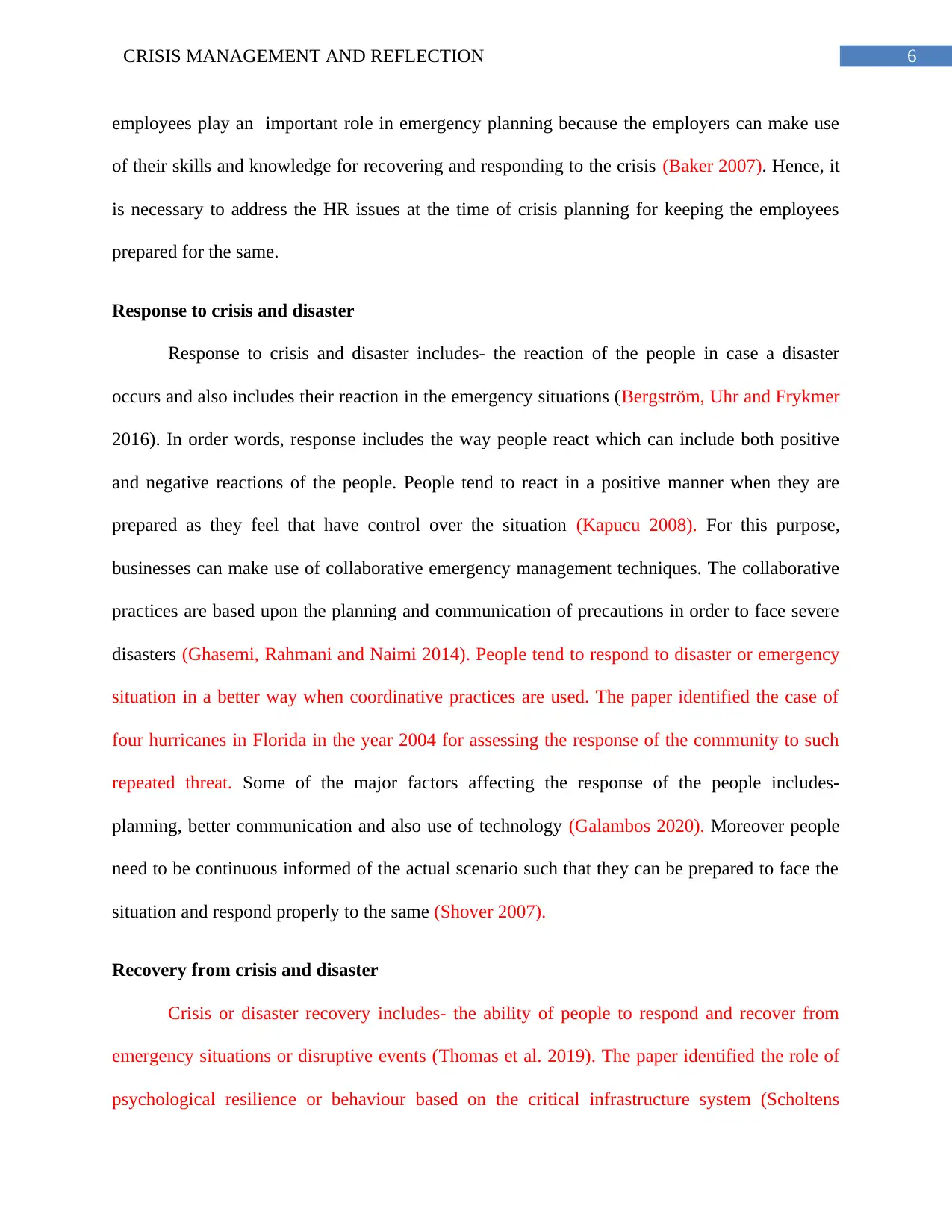
6CRISIS MANAGEMENT AND REFLECTION
employees play an important role in emergency planning because the employers can make use
of their skills and knowledge for recovering and responding to the crisis (Baker 2007). Hence, it
is necessary to address the HR issues at the time of crisis planning for keeping the employees
prepared for the same.
Response to crisis and disaster
Response to crisis and disaster includes- the reaction of the people in case a disaster
occurs and also includes their reaction in the emergency situations (Bergström, Uhr and Frykmer
2016). In order words, response includes the way people react which can include both positive
and negative reactions of the people. People tend to react in a positive manner when they are
prepared as they feel that have control over the situation (Kapucu 2008). For this purpose,
businesses can make use of collaborative emergency management techniques. The collaborative
practices are based upon the planning and communication of precautions in order to face severe
disasters (Ghasemi, Rahmani and Naimi 2014). People tend to respond to disaster or emergency
situation in a better way when coordinative practices are used. The paper identified the case of
four hurricanes in Florida in the year 2004 for assessing the response of the community to such
repeated threat. Some of the major factors affecting the response of the people includes-
planning, better communication and also use of technology (Galambos 2020). Moreover people
need to be continuous informed of the actual scenario such that they can be prepared to face the
situation and respond properly to the same (Shover 2007).
Recovery from crisis and disaster
Crisis or disaster recovery includes- the ability of people to respond and recover from
emergency situations or disruptive events (Thomas et al. 2019). The paper identified the role of
psychological resilience or behaviour based on the critical infrastructure system (Scholtens
employees play an important role in emergency planning because the employers can make use
of their skills and knowledge for recovering and responding to the crisis (Baker 2007). Hence, it
is necessary to address the HR issues at the time of crisis planning for keeping the employees
prepared for the same.
Response to crisis and disaster
Response to crisis and disaster includes- the reaction of the people in case a disaster
occurs and also includes their reaction in the emergency situations (Bergström, Uhr and Frykmer
2016). In order words, response includes the way people react which can include both positive
and negative reactions of the people. People tend to react in a positive manner when they are
prepared as they feel that have control over the situation (Kapucu 2008). For this purpose,
businesses can make use of collaborative emergency management techniques. The collaborative
practices are based upon the planning and communication of precautions in order to face severe
disasters (Ghasemi, Rahmani and Naimi 2014). People tend to respond to disaster or emergency
situation in a better way when coordinative practices are used. The paper identified the case of
four hurricanes in Florida in the year 2004 for assessing the response of the community to such
repeated threat. Some of the major factors affecting the response of the people includes-
planning, better communication and also use of technology (Galambos 2020). Moreover people
need to be continuous informed of the actual scenario such that they can be prepared to face the
situation and respond properly to the same (Shover 2007).
Recovery from crisis and disaster
Crisis or disaster recovery includes- the ability of people to respond and recover from
emergency situations or disruptive events (Thomas et al. 2019). The paper identified the role of
psychological resilience or behaviour based on the critical infrastructure system (Scholtens
Paraphrase This Document
Need a fresh take? Get an instant paraphrase of this document with our AI Paraphraser
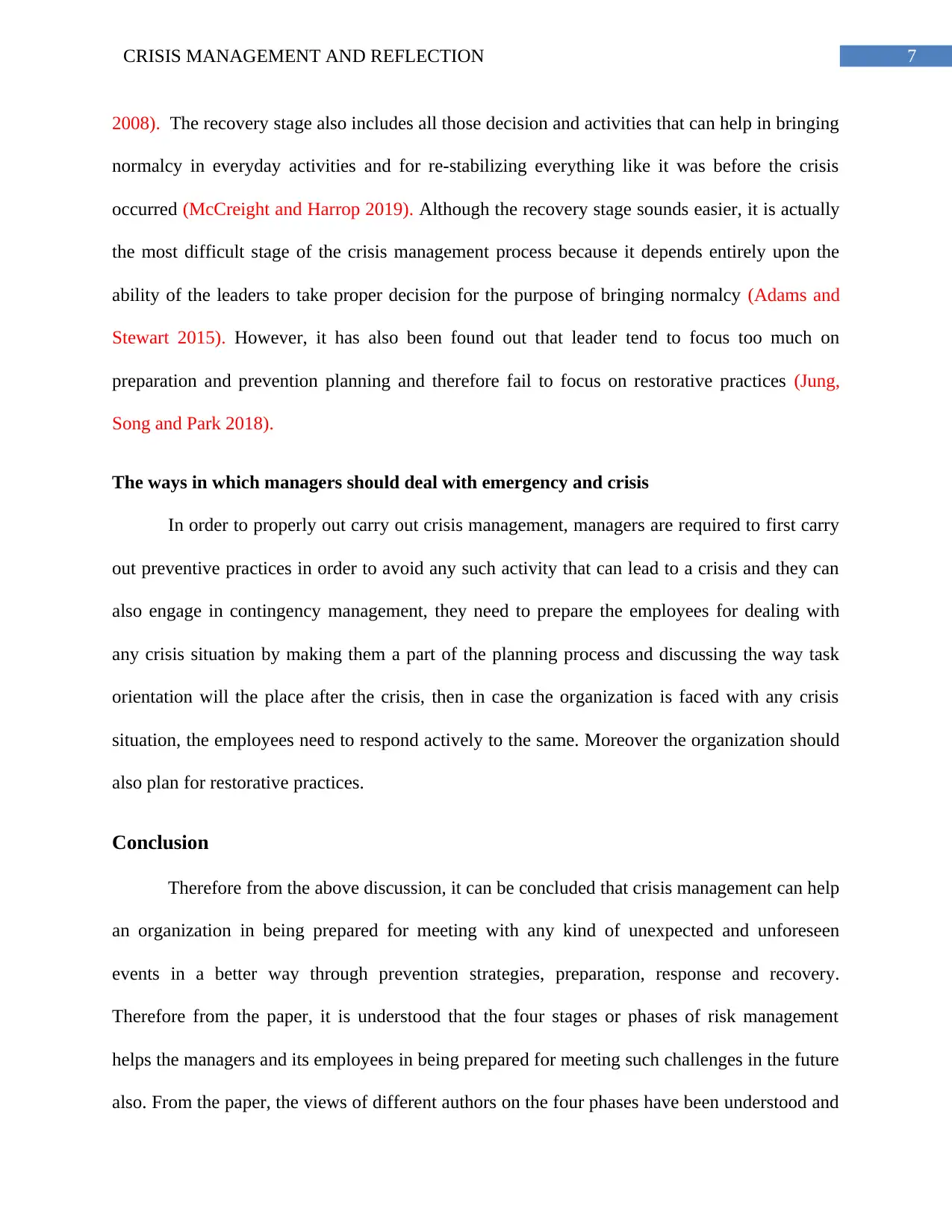
7CRISIS MANAGEMENT AND REFLECTION
2008). The recovery stage also includes all those decision and activities that can help in bringing
normalcy in everyday activities and for re-stabilizing everything like it was before the crisis
occurred (McCreight and Harrop 2019). Although the recovery stage sounds easier, it is actually
the most difficult stage of the crisis management process because it depends entirely upon the
ability of the leaders to take proper decision for the purpose of bringing normalcy (Adams and
Stewart 2015). However, it has also been found out that leader tend to focus too much on
preparation and prevention planning and therefore fail to focus on restorative practices (Jung,
Song and Park 2018).
The ways in which managers should deal with emergency and crisis
In order to properly out carry out crisis management, managers are required to first carry
out preventive practices in order to avoid any such activity that can lead to a crisis and they can
also engage in contingency management, they need to prepare the employees for dealing with
any crisis situation by making them a part of the planning process and discussing the way task
orientation will the place after the crisis, then in case the organization is faced with any crisis
situation, the employees need to respond actively to the same. Moreover the organization should
also plan for restorative practices.
Conclusion
Therefore from the above discussion, it can be concluded that crisis management can help
an organization in being prepared for meeting with any kind of unexpected and unforeseen
events in a better way through prevention strategies, preparation, response and recovery.
Therefore from the paper, it is understood that the four stages or phases of risk management
helps the managers and its employees in being prepared for meeting such challenges in the future
also. From the paper, the views of different authors on the four phases have been understood and
2008). The recovery stage also includes all those decision and activities that can help in bringing
normalcy in everyday activities and for re-stabilizing everything like it was before the crisis
occurred (McCreight and Harrop 2019). Although the recovery stage sounds easier, it is actually
the most difficult stage of the crisis management process because it depends entirely upon the
ability of the leaders to take proper decision for the purpose of bringing normalcy (Adams and
Stewart 2015). However, it has also been found out that leader tend to focus too much on
preparation and prevention planning and therefore fail to focus on restorative practices (Jung,
Song and Park 2018).
The ways in which managers should deal with emergency and crisis
In order to properly out carry out crisis management, managers are required to first carry
out preventive practices in order to avoid any such activity that can lead to a crisis and they can
also engage in contingency management, they need to prepare the employees for dealing with
any crisis situation by making them a part of the planning process and discussing the way task
orientation will the place after the crisis, then in case the organization is faced with any crisis
situation, the employees need to respond actively to the same. Moreover the organization should
also plan for restorative practices.
Conclusion
Therefore from the above discussion, it can be concluded that crisis management can help
an organization in being prepared for meeting with any kind of unexpected and unforeseen
events in a better way through prevention strategies, preparation, response and recovery.
Therefore from the paper, it is understood that the four stages or phases of risk management
helps the managers and its employees in being prepared for meeting such challenges in the future
also. From the paper, the views of different authors on the four phases have been understood and

8CRISIS MANAGEMENT AND REFLECTION
the key findings regarding the way managers deal with crisis and emergency have also been
understood from the paper.
the key findings regarding the way managers deal with crisis and emergency have also been
understood from the paper.
⊘ This is a preview!⊘
Do you want full access?
Subscribe today to unlock all pages.

Trusted by 1+ million students worldwide

9CRISIS MANAGEMENT AND REFLECTION
References
Adams, T.M. and Stewart, L.D., 2015. Chaos theory and organizational crisis: A theoretical
analysis of the challenges faced by the New Orleans Police Department during Hurricane
Katrina. Public organization review, 15(3), pp.415-431.
Ahrens, J. and Rudolph, P.M., 2006. The importance of governance in risk reduction and disaster
management. Journal of contingencies and crisis management, 14(4), pp.207-220.
Baker, M., 2007. Creating Order from Chaos: Part I: Triage, Initial Care, and Tactical
Considerations in Mass Casualty and Disaster Response. Military Medicine, 172(3), pp.232-236.
Galambos, C., 2020. Natural Disasters: Health And Mental Health Considerations.
Ghasemi, F., Rahmani, E., Naimi, Q. and Dalir, M., 2014. To Study the Effect of Crisis
Management in Reducing the Damages Caused by Earthquake in Urban Decay;(Case study:
Chahbahar Town). Kuwait Chapter of the Arabian Journal of Business and Management
Review, 3(10), p.59.
Jung, K., Song, M. and Park, H.W., 2018. Filling the gap between bureaucratic and adaptive
approaches to crisis management: lessons from the Sewol Ferry sinking in South Korea. Quality
& Quantity, 52(1), pp.277-294.
Kapucu, N., 2008. Collaborative emergency management: better community organising, better
public preparedness and response. Disasters, 32(2), pp.239-262.
Mann, S., 2014. Human resources and emergency planning: Preparing local governments for
times of crisis. Public Administration Quarterly, pp.163-205.
References
Adams, T.M. and Stewart, L.D., 2015. Chaos theory and organizational crisis: A theoretical
analysis of the challenges faced by the New Orleans Police Department during Hurricane
Katrina. Public organization review, 15(3), pp.415-431.
Ahrens, J. and Rudolph, P.M., 2006. The importance of governance in risk reduction and disaster
management. Journal of contingencies and crisis management, 14(4), pp.207-220.
Baker, M., 2007. Creating Order from Chaos: Part I: Triage, Initial Care, and Tactical
Considerations in Mass Casualty and Disaster Response. Military Medicine, 172(3), pp.232-236.
Galambos, C., 2020. Natural Disasters: Health And Mental Health Considerations.
Ghasemi, F., Rahmani, E., Naimi, Q. and Dalir, M., 2014. To Study the Effect of Crisis
Management in Reducing the Damages Caused by Earthquake in Urban Decay;(Case study:
Chahbahar Town). Kuwait Chapter of the Arabian Journal of Business and Management
Review, 3(10), p.59.
Jung, K., Song, M. and Park, H.W., 2018. Filling the gap between bureaucratic and adaptive
approaches to crisis management: lessons from the Sewol Ferry sinking in South Korea. Quality
& Quantity, 52(1), pp.277-294.
Kapucu, N., 2008. Collaborative emergency management: better community organising, better
public preparedness and response. Disasters, 32(2), pp.239-262.
Mann, S., 2014. Human resources and emergency planning: Preparing local governments for
times of crisis. Public Administration Quarterly, pp.163-205.
Paraphrase This Document
Need a fresh take? Get an instant paraphrase of this document with our AI Paraphraser
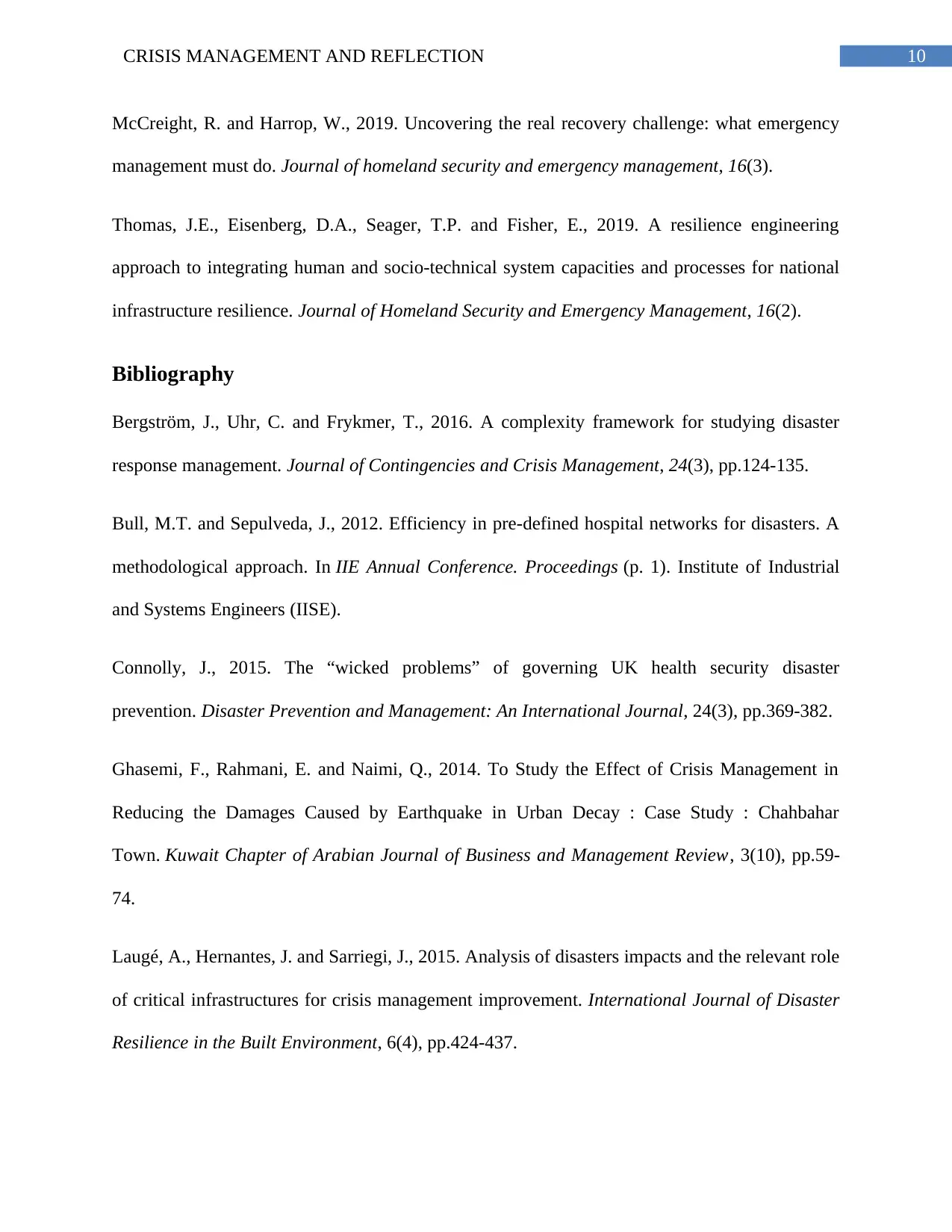
10CRISIS MANAGEMENT AND REFLECTION
McCreight, R. and Harrop, W., 2019. Uncovering the real recovery challenge: what emergency
management must do. Journal of homeland security and emergency management, 16(3).
Thomas, J.E., Eisenberg, D.A., Seager, T.P. and Fisher, E., 2019. A resilience engineering
approach to integrating human and socio-technical system capacities and processes for national
infrastructure resilience. Journal of Homeland Security and Emergency Management, 16(2).
Bibliography
Bergström, J., Uhr, C. and Frykmer, T., 2016. A complexity framework for studying disaster
response management. Journal of Contingencies and Crisis Management, 24(3), pp.124-135.
Bull, M.T. and Sepulveda, J., 2012. Efficiency in pre-defined hospital networks for disasters. A
methodological approach. In IIE Annual Conference. Proceedings (p. 1). Institute of Industrial
and Systems Engineers (IISE).
Connolly, J., 2015. The “wicked problems” of governing UK health security disaster
prevention. Disaster Prevention and Management: An International Journal, 24(3), pp.369-382.
Ghasemi, F., Rahmani, E. and Naimi, Q., 2014. To Study the Effect of Crisis Management in
Reducing the Damages Caused by Earthquake in Urban Decay : Case Study : Chahbahar
Town. Kuwait Chapter of Arabian Journal of Business and Management Review, 3(10), pp.59-
74.
Laugé, A., Hernantes, J. and Sarriegi, J., 2015. Analysis of disasters impacts and the relevant role
of critical infrastructures for crisis management improvement. International Journal of Disaster
Resilience in the Built Environment, 6(4), pp.424-437.
McCreight, R. and Harrop, W., 2019. Uncovering the real recovery challenge: what emergency
management must do. Journal of homeland security and emergency management, 16(3).
Thomas, J.E., Eisenberg, D.A., Seager, T.P. and Fisher, E., 2019. A resilience engineering
approach to integrating human and socio-technical system capacities and processes for national
infrastructure resilience. Journal of Homeland Security and Emergency Management, 16(2).
Bibliography
Bergström, J., Uhr, C. and Frykmer, T., 2016. A complexity framework for studying disaster
response management. Journal of Contingencies and Crisis Management, 24(3), pp.124-135.
Bull, M.T. and Sepulveda, J., 2012. Efficiency in pre-defined hospital networks for disasters. A
methodological approach. In IIE Annual Conference. Proceedings (p. 1). Institute of Industrial
and Systems Engineers (IISE).
Connolly, J., 2015. The “wicked problems” of governing UK health security disaster
prevention. Disaster Prevention and Management: An International Journal, 24(3), pp.369-382.
Ghasemi, F., Rahmani, E. and Naimi, Q., 2014. To Study the Effect of Crisis Management in
Reducing the Damages Caused by Earthquake in Urban Decay : Case Study : Chahbahar
Town. Kuwait Chapter of Arabian Journal of Business and Management Review, 3(10), pp.59-
74.
Laugé, A., Hernantes, J. and Sarriegi, J., 2015. Analysis of disasters impacts and the relevant role
of critical infrastructures for crisis management improvement. International Journal of Disaster
Resilience in the Built Environment, 6(4), pp.424-437.
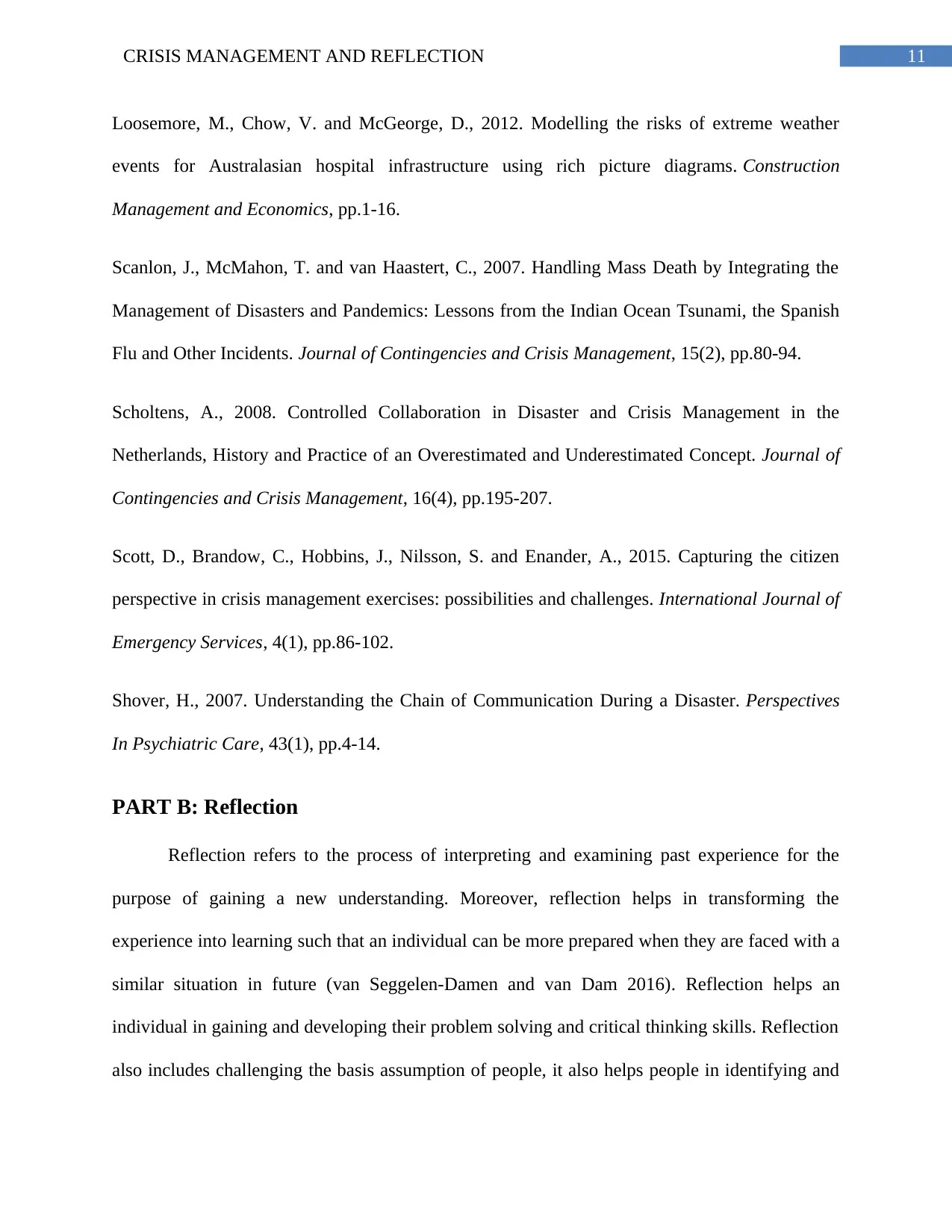
11CRISIS MANAGEMENT AND REFLECTION
Loosemore, M., Chow, V. and McGeorge, D., 2012. Modelling the risks of extreme weather
events for Australasian hospital infrastructure using rich picture diagrams. Construction
Management and Economics, pp.1-16.
Scanlon, J., McMahon, T. and van Haastert, C., 2007. Handling Mass Death by Integrating the
Management of Disasters and Pandemics: Lessons from the Indian Ocean Tsunami, the Spanish
Flu and Other Incidents. Journal of Contingencies and Crisis Management, 15(2), pp.80-94.
Scholtens, A., 2008. Controlled Collaboration in Disaster and Crisis Management in the
Netherlands, History and Practice of an Overestimated and Underestimated Concept. Journal of
Contingencies and Crisis Management, 16(4), pp.195-207.
Scott, D., Brandow, C., Hobbins, J., Nilsson, S. and Enander, A., 2015. Capturing the citizen
perspective in crisis management exercises: possibilities and challenges. International Journal of
Emergency Services, 4(1), pp.86-102.
Shover, H., 2007. Understanding the Chain of Communication During a Disaster. Perspectives
In Psychiatric Care, 43(1), pp.4-14.
PART B: Reflection
Reflection refers to the process of interpreting and examining past experience for the
purpose of gaining a new understanding. Moreover, reflection helps in transforming the
experience into learning such that an individual can be more prepared when they are faced with a
similar situation in future (van Seggelen-Damen and van Dam 2016). Reflection helps an
individual in gaining and developing their problem solving and critical thinking skills. Reflection
also includes challenging the basis assumption of people, it also helps people in identifying and
Loosemore, M., Chow, V. and McGeorge, D., 2012. Modelling the risks of extreme weather
events for Australasian hospital infrastructure using rich picture diagrams. Construction
Management and Economics, pp.1-16.
Scanlon, J., McMahon, T. and van Haastert, C., 2007. Handling Mass Death by Integrating the
Management of Disasters and Pandemics: Lessons from the Indian Ocean Tsunami, the Spanish
Flu and Other Incidents. Journal of Contingencies and Crisis Management, 15(2), pp.80-94.
Scholtens, A., 2008. Controlled Collaboration in Disaster and Crisis Management in the
Netherlands, History and Practice of an Overestimated and Underestimated Concept. Journal of
Contingencies and Crisis Management, 16(4), pp.195-207.
Scott, D., Brandow, C., Hobbins, J., Nilsson, S. and Enander, A., 2015. Capturing the citizen
perspective in crisis management exercises: possibilities and challenges. International Journal of
Emergency Services, 4(1), pp.86-102.
Shover, H., 2007. Understanding the Chain of Communication During a Disaster. Perspectives
In Psychiatric Care, 43(1), pp.4-14.
PART B: Reflection
Reflection refers to the process of interpreting and examining past experience for the
purpose of gaining a new understanding. Moreover, reflection helps in transforming the
experience into learning such that an individual can be more prepared when they are faced with a
similar situation in future (van Seggelen-Damen and van Dam 2016). Reflection helps an
individual in gaining and developing their problem solving and critical thinking skills. Reflection
also includes challenging the basis assumption of people, it also helps people in identifying and
⊘ This is a preview!⊘
Do you want full access?
Subscribe today to unlock all pages.

Trusted by 1+ million students worldwide
1 out of 22
Related Documents
Your All-in-One AI-Powered Toolkit for Academic Success.
+13062052269
info@desklib.com
Available 24*7 on WhatsApp / Email
![[object Object]](/_next/static/media/star-bottom.7253800d.svg)
Unlock your academic potential
Copyright © 2020–2025 A2Z Services. All Rights Reserved. Developed and managed by ZUCOL.




